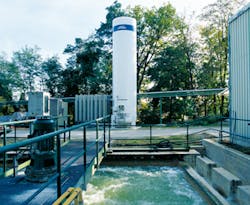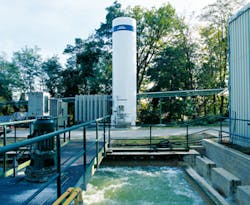Alkaline wastewaters are generated in meat, food and beverage processing operations as well as many other chemical and industrial operations. Cleaning solutions with high pH levels are often used to clean equipment for processing fats, plant matter and other biological or organic compounds. If pH levels of wastewater discharges exceed National Pollutant Discharge Elimination System (NPDES) permitted levels, they must be reported, subjecting plants to environmental fines and public scrutiny.
The SOLVOCARB® process from Linde North America provides a fast and economical way for process industries to neutralize alkaline wastewater with a high degree of control using carbon dioxide (CO2). During the process, the inert gas is injected into the wastewater, and once dissolved, CO2 forms carbonic acid that can quickly reduce pH to appropriate levels for discharge, and natural buffering prevents overshooting pH levels.
Neutralizing alkaline wastewater with mineral acids has been a logical approach; however, the past few years have seen prices spike for both HCl and H2SO4. Besides pricing issues, there are also storage, safety and handling issues of highly corrosive acids. With mineral acids, a few drops too many can create pH excursions, which risk discharge fines from the treatment authority or the Environmental Protection Agency (EPA). In addition, they take a toll on storage and processing equipment, and worker safety and maintenance procedures are constant concerns.
Minimizing or eliminating the use of hazardous chemicals in wastewater treatment systems supports sustainability goals and reduces risks. The soft and hard costs involved with these risks and uncertainties can move food processors to environmentally friendly alternatives.
The SOLVOCARB system is a sustainable alternative and safer than hazardous and corrosive mineral acid treatments. With it, CO2 can be injected into wastewater through a variety of methods and can reduce pH to neutral levels with a high degree of control. SOLVOCARB-B is used for open treatment tanks and lagoons via diffusion mats. SOLVOCARB-D is used for direct injection into wastewater pipes via a sparger. SOLVOCARB-R is used for injection into enclosed process tanks via special reactors.
Last year, the Linde water treatment team "rescued" a major pet food manufacturer from a failure in a sulfuric acid dosing system. The system overshot the set point, which dropped the pH of its wastewater down to 3, triggering a fine. With help from Linde, the problem was corrected with the SOLVOCARB-D method, eliminating the risk of overtreatment. A gas sparger was installed inside a 2-in. waste pipe to treat the process water as it flowed, and the gas was supplied on-site via a 30-ton vertical vacuum-jacketed tank.



